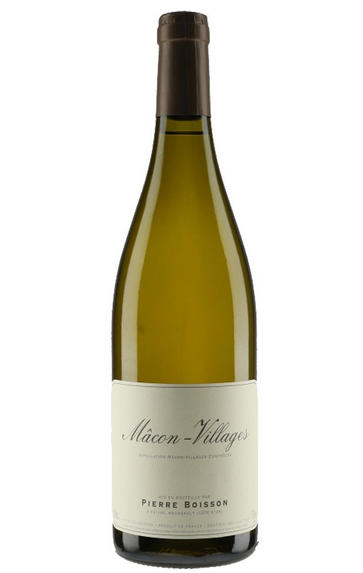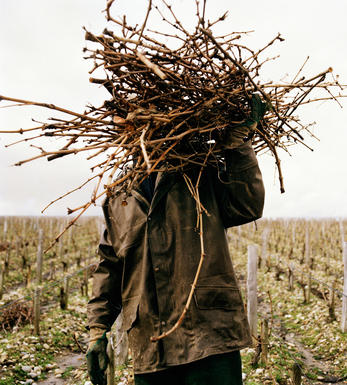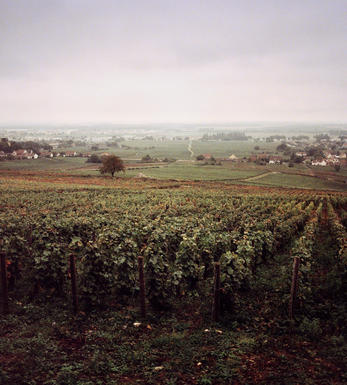
2020 Mâcon-Villages, Pierre Boisson, Burgundy

Critics reviews
A négociant bottling, the 2020 Mâcon-Villages (négoce) offers up aromas of clear honey, orange oil and mint, followed by a medium to full-bodied, ample and fleshy palate.
As ever, the inimitable Bernard Boisson presided over my annual tasting in his usual, refreshingly old-school manner, offering splashes from a variety of bottles, some open for several days and some opened for my benefit. As readers will remember, Bernard's holdings have been entirely divided between his son Pierre and daughter Anne. On this visit, Boisson père reiterated that in fact Pierre and Anne operate separately though cooperatively (Pierre taking care of all the tractor work in the vineyards) and vinify in their own way—though the two labels' styles are undeniably more similar than different.
As I've written before, in his day, Bernard Boisson was one of the village's latest harvesters, and his wines only spent a year on the lees, with much of the production sold to the négociants. With Pierre's arrival at the domaine some 15 years ago, that changed dramatically: The domaine has returned, as Bernard puts it, to do things as they were done in his grandfather's era. That means earlier harvesting, little débourbage, long sur lie élevage ranging from 19 to 22 months and restrained use of new oak—up to 30%, largely from Saint-Romain's Tonnellerie Gillet, recognizable for the toasty, nutty patina that it imparts.
The entire production is now bottled without filtration under natural cork. Increasingly, the communal and regional appellations are bottled with lieu-dit names, under either the Anne or the Pierre Boisson label.
Drink 2023 - 2027
William Kelley, Wine Advocate (January 2023)
About this WINE

Domaine Boisson-Vadot
Domaine Boisson-Vadot, run by father and son team of Bernard and Pierre Boisson, is one of the rising stars in Mersault. The philosophy of the Domaine revolves around careful, hands-on vineyard management to coax the greatest potential of each vintage out of the various plots, and low-impact winemaking in the cellars that allows the unique terroir of each vineyard to surface. New oak is very minimal, no more than 30% for the top cuvées, and much more restraint in the village wines and in Bourgogne Blanc.
Pierre Boisson produces a village Meursault from his grandmother’s vineyards (50 year old vines in the lieu-dits of Criots and Perchots) that is hailed an model wine for the appellation. The Domaine also crafts other bottlings, from three of the best lieux à dits in Meursault: Sous la Velle , Grands Charrons (planted in 1988) and Chevalières (planted in 1982). The Grands Charrons is the most expressive, intensely flavoured of the three. The Sous la Velle is a more elegant version of the Grand Charrons. The Chevalières is the most mineral-driven, with a more restraint fruit flavours in its youth but great ageing potential- More like premier crus than village wines. Finally, Boisson-Vadot makes a powerful yet charming Meursault Genevrières premier cru.

Mâcon
The city of Mâcon represents the capital of the Mâconnais district in the region of Burgundy, to which it lends its name. There are various appellations under the name Mâcon: the generic Mâcon AC, Mâcon Supérieur and the Mâcon-Villages, in ascending order of how much land each appellation entails.
The standard Mâcon AC controls around 53 hectares of vineyard, 70 percent of which is used to produce just white wine, primarily from the Chardonnay grape. Mâcon used to be recognised for its red wines, but in the last century Mâconnais whites have come to the forefront far more. This generic appellation represents a specific style of wine made across the Mâconnais district, rather than an appellation which would cover a select area or terroir.
The ‘Supérieur’ in Mâcon Supérieur refers not to an increase in quality but rather to the boost in alcohol content, a term which can be applied to either red or white wines.
Mâcon-Villages is a specific appellation which refers to white wines produced in certain areas of the Mâconnais region, and usually denotes an improvement in quality over the straightforward Mâcon AC wines.
Many of the small communes under the Mâcon classification opt to add their name to that of the appellation on their wines; notable examples include La Roche Vineuse, Uchizy and Lugny.
Wines from Mâcon tend to be uncomplicated affairs, simple but enjoyable, and the whites in particular are notable for their dry, light bodies and the presence of floral and nutty facets.

Chardonnay
Chardonnay is often seen as the king of white wine grapes and one of the most widely planted in the world It is suited to a wide variety of soils, though it excels in soils with a high limestone content as found in Champagne, Chablis, and the Côte D`Or.
Burgundy is Chardonnay's spiritual home and the best White Burgundies are dry, rich, honeyed wines with marvellous poise, elegance and balance. They are unquestionably the finest dry white wines in the world. Chardonnay plays a crucial role in the Champagne blend, providing structure and finesse, and is the sole grape in Blanc de Blancs.
It is quantitatively important in California and Australia, is widely planted in Chile and South Africa, and is the second most widely planted grape in New Zealand. In warm climates Chardonnay has a tendency to develop very high sugar levels during the final stages of ripening and this can occur at the expense of acidity. Late picking is a common problem and can result in blowsy and flabby wines that lack structure and definition.
Recently in the New World, we have seen a move towards more elegant, better- balanced and less oak-driven Chardonnays, and this is to be welcomed.


Buying options
Add to wishlist
Description
A négociant bottling, the 2020 Mâcon-Villages (négoce) offers up aromas of clear honey, orange oil and mint, followed by a medium to full-bodied, ample and fleshy palate.
As ever, the inimitable Bernard Boisson presided over my annual tasting in his usual, refreshingly old-school manner, offering splashes from a variety of bottles, some open for several days and some opened for my benefit. As readers will remember, Bernard's holdings have been entirely divided between his son Pierre and daughter Anne. On this visit, Boisson père reiterated that in fact Pierre and Anne operate separately though cooperatively (Pierre taking care of all the tractor work in the vineyards) and vinify in their own way—though the two labels' styles are undeniably more similar than different.
As I've written before, in his day, Bernard Boisson was one of the village's latest harvesters, and his wines only spent a year on the lees, with much of the production sold to the négociants. With Pierre's arrival at the domaine some 15 years ago, that changed dramatically: The domaine has returned, as Bernard puts it, to do things as they were done in his grandfather's era. That means earlier harvesting, little débourbage, long sur lie élevage ranging from 19 to 22 months and restrained use of new oak—up to 30%, largely from Saint-Romain's Tonnellerie Gillet, recognizable for the toasty, nutty patina that it imparts.
The entire production is now bottled without filtration under natural cork. Increasingly, the communal and regional appellations are bottled with lieu-dit names, under either the Anne or the Pierre Boisson label.
Drink 2023 - 2027
William Kelley, Wine Advocate (January 2023)
wine at a glance
Delivery and quality guarantee